Recent Updates
10/25/2024 12:00 PM
How head-up display screens can make cars safer
10/25/2024 12:00 PM
Hyundai RN24 is rolling test bed that previews future hot EVs
10/25/2024 12:00 AM
International Harvester Scout revived as electric SUV and pick-up
10/24/2024 12:00 PM
Pricey but tempting: the business case for in-wheel motors
10/24/2024 12:00 PM
New vs used showdown: How much car can you get for your money?
10/24/2024 12:00 PM
LPG in decline as incentives disappear and pumps close
10/24/2024 12:00 PM
Stellantis to begin road testing solid-state batteries in 2026
10/23/2024 12:00 PM
Autocar magazine 23 October: on sale now
10/23/2024 12:00 PM
My Week In Cars: New Steve Cropley/Matt Prior podcast (ep.111)
10/23/2024 12:00 PM
Jaguar builds new E-Types 50 years after GT's retirement
EV, Hybrid, Hydrogen, Solar & more 21st century mobility!

With prices starting around £15,000, the V10 Audi RS6 is actually our cheapest option – to buy, at least...We pit desirable brand-new cars against more alluring, yet risky, used alternatives for the same price
I know what you’re thinking: we’ve really lost the plot this time. A Hyundai taking the fight to a Porsche?
AÂ Kia SUVÂ versus a full-fat Range Rover? A 572 bhp V10 up against a PHEV? Surely not.
On the surface this lineup almost seems like a fever dream. But dig a little deeper and dare we say, they almost make sense.
Do you pick the sensible brand-new car or the more alluring yet risky used one for the same price? It’s a quandary no pub argument has ever solved, but we think we some answers.Â
Porsche Taycan vs Hyundai Ioniq 5 N

One of the cars you see here is built by a manufacturer steeped in high-performance tradition and bears a badge that sits at the top of most brand analysts’ ‘most wanted’ lists.
The other has been engineered by a firm that not that long ago was best known for its sensible model line-up, affordable pricing and lengthy warranties. Worthy? Yes. Desirable? Erm, nope. Simply put, never the twain shall meet.
But dig a little deeper and you’ll find a mixture of depreciation and bold ambition that means the two protagonists here have more in common than you might think, making them perfect sparring partners for a new versus used encounter.
You see, so volatile are the current markets for pre-owned motors and factory-fresh machines that buyers are having their heads turned in all sorts of directions towards cars they may never have previously considered opening their wallets for.
Let’s take Porsche Taycan as an example. Porsche’s pioneering EV set the standard for battery-powered driver’s cars when it burst onto the scene four years ago and it still represents a high-water mark today.
Yet despite the flurry of excitement and consumer interest around its launch, sales of the Taycan soon took a hit. Initially, buyers’ interest in the car was piqued, but then it quickly peaked.
The result is that used values have slumped as original owners load up the used market with their cast-offs. So you can now pick up an early and well-used Taycan (but still only four years old, remember) for as little as £40,000. That’s a slump in value of more than 50%. Ouch!
As for the specific car you see here, it’s from our long-term test fleet and was plucked from the price lists of Porsche’s Approved Pre-Owned scheme. It’s an entry-level, 23-plate Sport Turismo with around 10,000 miles on the clock.
When new – less than a year ago – it would have set its first owner back £80,255. And that’s before the inevitable options. Today? You could probably secure the keys to it for about £65,000. Double ouch!
At that price, it steps right into the crosshairs of one of the most exciting new EVs of the year: the Hyundai Ioniq 5 N, which can also be yours for £65,000. At first glance, the boxy Korean machine doesn’t look like much of a Porsche rival, but in reality there’s plenty of crossover.
With its raised roofline and large estate-style boot, the Sport Turismo provides a similar amount of family-friendly appeal to the Ioniq 5. Meanwhile, the Hyundai has Porsche-baiting pace and poise courtesy of its powerful dual-motor set-up and highly honed suspension. Essentially, with their mix of poise and practicality, this pair plough similar furrows.
Despite its sleek lines, muscular haunches and the lure of that Porsche crest on the bonnet, the Taycan has to give best to the hot hatch-infused Hyundai for immediate visual impact.
The standard Ioniq 5’s sharp-edged profile is distinctive enough, but throw in this N version’s racy bodykit, a large rear spoiler, vast 21in alloy wheels and some red pinstriping, and the peacocking Hyundai’s head-turning credentials are complete.
However, look past its pocket-rocket vibes and you will find the Ioniq 5 is a big car. Hyundai has done a good job of disguising the car’s dimensions, but parked alongside the Taycan, the N’s tape-measure-stretching proportions are clear. It’s taller than the Porsche, obviously, but what’s more surprising is that, at 1940mm, it’s only 26mm narrower.
So this is a car that will require you to breathe in on tighter roads. That said, the Ioniq better translates its external bulk into cabin space, with lots of room for five people and a larger luggage area.
What it can’t match is the Taycan’s exquisite finish and rich materials, even if the overall quality is high. The Hyundai doesn’t limit its numbers advantage to size and space, because it also has the upper hand when it comes to the performance stats.
With its dual-motor set-up, the Ioniq 5 N packs a frankly outrageous 641bhp (in short bursts; 601bhp is the standard tune). And with 568lb ft on tap, it generates enough torque to hold anyone’s attention.
So the performance is mind-bending, as evidenced by the 3.5sec 0-60mph time the car recorded when we road tested it (Autocar, 7 August).

If anything, the Hyundai feels even quicker than that in the real world, responding with such force and energy to your right foot that it’s hard to stifle an involuntary giggle.
And that’s before you get to the car’s ‘virtual’ eight-speed automatic transmission, which can be engaged at the tap of a steering wheel-mounted N button. It sounds gimmicky but in practice works freakishly well, providing just the right pause between ratios and a real sense of the motor ‘labouring’ when, say, you select eighth at 30mph and plant your foot fully on the throttle.
The mind boggles at how difficult this must have been to engineer, but the results are remarkably effective, creating an extra layer of connection between car and driver. The less said about the synthetic engine note that accompanies it, however, the better.
The Taycan can’t match the Hyundai’s ICE-aping high jinks or its firepower, but there is still fun to be had here. Entry-level guise means ‘just’ 402bhp and a 0-62mph time of 5.4sec, but the Sport Turismo never feels less than rapid, even if it can’t quite hold onto the red-striped coat-tails of the N.
If you want more performance, then privately advertised and higher-mileage examples of the 523bhp 4S are available for similar money.
Yet it’s the Taycan’s chassis that shines the brightest, its blend of composure and communication proving to be pure Porsche. On its standard steel springs, this Taycan rides with a suppleness that the Hyundai can’t match, particularly over sharper imperfections, where the Ioniq 5 N gets a little crashy. There’s real refinement here and the Porsche can effortlessly play the role of executive express.
Sharpen the adaptive dampers and the Taycan channels the spirit of the 911, feeling taut and alert as it responds crisply to slick and naturally weighted steering that has just the right rate of response.
Despite its size and weight, the Porsche is wieldy and agile, while the single-motor set-up delivers deliciously adjustable handling. The instant torque allows you to dial in as much or as little angle on corner exit as you like.
What’s more, it’s a doddle to access the Porsche’s wide dynamic repertoire because its various drive modes are just a finger flick away with the handy wheel-mounted rotary selector. By contrast, the Hyundai is an RTFM (read the f****** manual) kind of car.
As with the departed N-flavoured i20 and i30, interrogating the Ioniq 5 N’s dizzying array of set-up options is a bit of an Alice-down-the-rabbit-hole experience.
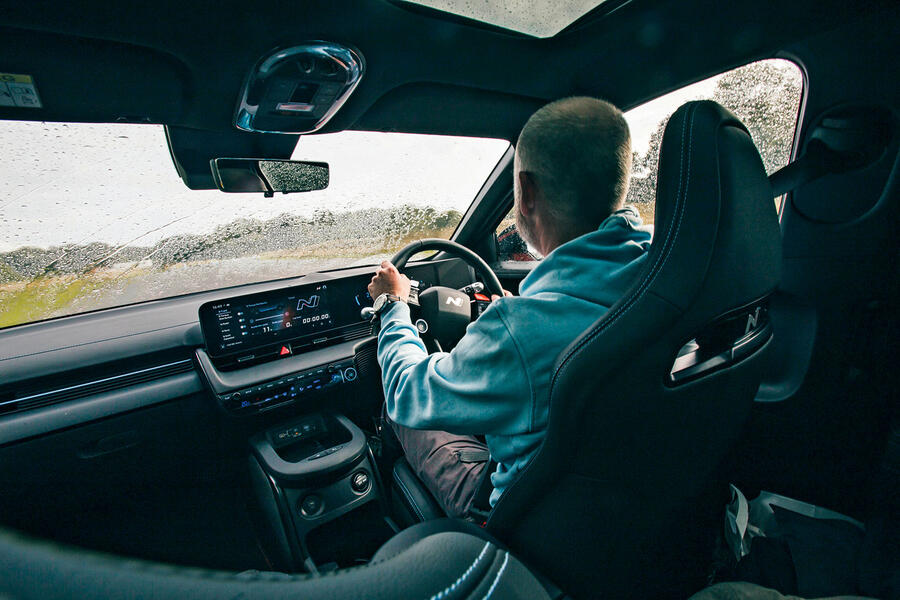
Not only can you fine-tune the Ioniq 5 N’s dampers, steering and electronic limited-slip rear differential, but there’s even the opportunity to tailor the torque split between the motors. Does sir require front-wheel drive only? Step this way. Perhaps madam would like rear-wheel drive today? No problem: just press this.
Still, the Ioniq 5 N gets the basics right. You don’t sit as low and snug as in the Porsche, but the figure-hugging seats are sited 20mm lower than the standard car’s so you now feel like you’re placed in rather than on the Hyundai. In its default settings, the Hyundai is as smooth and easy-going as the regular version.
Ramp up the drive modes and the N is transformed from mild-mannered to manic. It never truly shrinks around you, but the 5 N feels alive when pressing on, cleverly disguising its mass (a hefty 2235kg, which is 155kg more than the Taycan) to deliver real back-road balletics.
There’s bags of front-end grip and the body control is superb, enabling a fast, flat cornering attitude. Trailing the brakes into a corner delivers a real attitude change on corner entry, while that adjustable torque split allows a flourish (or rather more if you wish, although you will be taking up a lot of the road) of power oversteer.
Clearly, there’s a lot of computing power happening here and you can just feel the systems at work as they fight physics, but most of the time it feels natural enough.
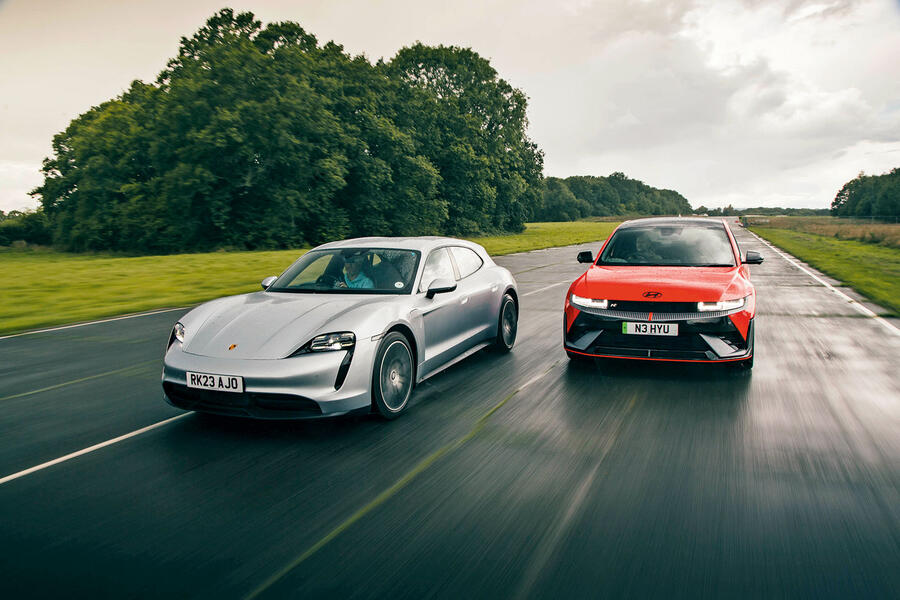
Special praise is reserved for the steering, which is fast, well weighted and blessed with some gritty feedback. The same goes for the brakes, which are meaty in response and easy to modulate. Factor in those simulated gearchanges and you’ll be grinning from ear to ear as you blast from A to B.
Is it as good to drive as the Porsche? Yes, but in a different, more energetic and rabble-rousing way. It lacks the Taycan’s ultimate balance and precision, but it counters that with greater chuckability and an infectious sense of mischievousness and fun.
How about the sensible stuff? The Porsche is a used car after all, albeit a relatively lightly used one. But you’ll still be covered by the new car warranty and an eight-year battery warranty, and so should avoid any big bills. The Hyundai is still too new to judge its ultimate durability, of course, but the standard car’s record appears fairly blemish-free, plus all models are covered by the brand’s excellent five-year guarantee. But it has yet to undergo the inevitable early hit of devaluation that the Taycan has already suffered with.
So overall, this is a close call. Ultimately, we would be happy with either of these cars, each of which proves that keen drivers needn’t mourn the demise of ICE.
However, by the width of a 275-section Pirelli, we’d plump for the slightly greater bandwidth and fun-loving charm of the remarkable Ioniq 5 N. So Hyundai beats Porsche. That’s a sentence I never thought I’d write.
Volkswagen Passat vs Audi RS6 Avant

The fast-estate class is changing, erm, fast. Ever-tightening emissions legislation is having a profound effect on lightning-fast load luggers, with the result that many car makers are looking to electrification to ensure they can still deliver a compelling blend of space and pace.
For example, the latest Mercedes-AMG C63 is a plug-in hybrid, as is the forthcoming BMW M5 Touring. And you can bet your bottom pfennig the next Audi RS6’s brute force will be battery-assisted.
Yet this adoption of electricity isn’t limited to models that now require a six-figure entry fee. For example, Volkswagen has just pulled the covers off its swiftest and most spacious plug-in Passat estate ever. Packing 268bhp and an injection of attitude from the brand’s high-performance R division, the eHybrid R-Line can be yours for £51,170.
That’s a price point that offers up a number of tempting pre-owned options.
However, if we’re talking machines that combine space and speed, then it’s Audi’s RS models that set the template. The Porsche-fettled RS2 celebrates its 30th birthday this year, while the larger RS6 has long been considered the daddy of them all. At this budget the 2013 ‘C7’ generation would be a good catch, its mix of modernity and understated styling arguably making it the RS6 peak.
Yet as we face down the possible extinction of combustion engines, there’s a strong temptation to go out in style, which is why the earlier C6 and its ludicrous twin-turbocharged 5.0-litre V10 (you know, the one that started life in the middle of a Lamborghini Gallardo) gets the nod.
For the brave, prices start at a ridiculously low £15,000, but an example like our immaculate 20,000-miler (borrowed from Audi UK’s heritage fleet) would leave a near Passat-sized hole in your wallet. Either way, you would probably want to spend a little less and bank the difference for running costs, but we’ll come back to that.
With a rippling 572bhp and Quattro four-wheel drive, the RS6 clearly has its box-fresh rival beaten for pace and performance theatre. It brings a sub-5.0sec dash to 62mph and a soundtrack that’s clearly been refined for everyday use but has enough of the Lambo’s operatic vocals to keep things interesting.
Even so, with 295lb ft of electrical assistance from its front-mounted motor, the VW isn’t disgraced, and in the cut and thrust of modern traffic its instant response means it rarely loses sight of the Audi, even if it lacks that car’s intoxicating top-end rush and appetite for revs.
Throw in some corners and the gaps diminish further, the Audi’s muscle and all-four traction countered by the Passat’s greater sophistication and compliance.
No matter which way you cut it, the Audi’s ride is firm, and while mid-corner bumps don’t throw it off line, progress can get crashy. Its weighty, hydraulically assisted steering requires real muscle, while almost all 10 cylinders of that firecracker of an engine hang out over the front-axle line, blunting the Avant’s agility. There’s no escaping it: this feels like an old car.
The VW is softer and its ultimate body control not as assured (even with the adaptive dampers turned up to 11), but like all models underpinned by the brand’s MQB architecture, there’s reassuring precision and poise. It rides better too, while its lighter controls and slick DSG gearbox make it the most easy-going everyday companion. And that’s before you factor in the silent and zippy 70-odd miles of EV running.

There are further gold stars for the Passat when it comes to practicality, because it offers the most rear leg room, more handy storage and a vast 1760 litres of boot space with the rear bench folded flat (the Audi offers 1660 litres in the same configuration).
On the plus side, the RS6’s interior still feels special and its use of physical buttons makes it easy to navigate the very dated infotainment. By contrast, the VW’s 15in screen is packed with features, but it’s so vast it acts as something of a distraction, while many commonly used functions are still buried in sub-menus.
Okay, so what about those running costs? We’re not going to sugar-coat it – the Audi will test the outer reaches of your overdraft. For starters, that V10 engine barely fits under the bonnet, so even simple jobs require hours of costly labour, while its massive torque means you should change gearbox fluid every 20,000 miles.
You will need to budget at least £1000 for a set of tyres, the same again for brakes and, you guessed it, another grand for a major service. Oh, and even if you drive as if your right foot were full of helium, you’ll struggle to hit 20mpg. The Passat? A claimed 694mpg…
No matter which way you cut it, the VW is the sensible choice, and this new ninth-generation version is the best yet. Spacious, classy, hugely efficient and good to drive, it covers all the family car bases. Problem is, it hasn’t got a V10.Â
Kia Sorento vs Range Rover
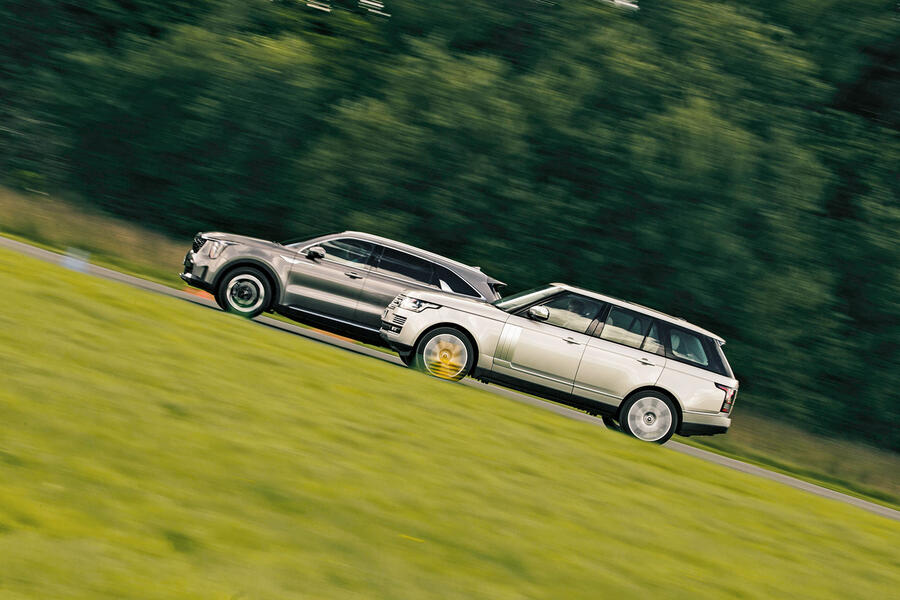
The push for premium means that almost every manufacturer looking to turn a profit now endows its products with a heavy dose of upmarket appeal.
Eye-catching exterior design is matched to an interior dripping in soft-touch plastics, cool metallic trim finishes and taut fit and finish, all of it pitched at buyers with carefully curated lifestyle ads that try to convince them they are getting a car that’s a cut above.
Few brands have so quickly and convincingly made the leap from the mainstream as Kia (and sibling firm Hyundai), with its larger SUVs leading the charge for style and sophistication.
These days it’s no longer a stretch to mention the Korean machines in the same breath as BMW, or argue their case against an Audi. But a Range Rover rival? Really?
The thing is, Kia’s speedy ascent of the ranks has come at a price. Literally. An entry-level version of its recently refreshed Sorento will set you back £41,995, while a fully loaded flagship 4 with plug-in hybrid power is a whisker under £56,000.
For that amount you can pick up a late example of the previous-generation (L405 to the spotters of Solihull’s finest) Range Rover with as little as 20,000 miles under its wheels.
An earlier car like this immaculate one-owner Autobiography with 75,000 on its digital odometer and supplied by specialist dealer Heel & Toe Cars (run by bona fide car nuts Christian and Billy. You’d like them) is around half that amount. Tempting? You betcha.
Thanks to its recent mid-life refresh, the Sorento gives surprisingly little away to the Rangie when it comes to arresting kerb appeal – although it’s a shame the Kia doesn’t have quite the impact of the firm’s bold EV9.
The L405, by contrast, is ageing gracefully, its aristocratic lines giving off a classier and more understated vibe than the current car’s rather more aggressive posturing.
It’s a similar story inside, where – old-fashioned infotainment aside (although post-facelift 2017 cars get JLR’s Pivi Pro set-up, meaning tech-heads will struggle to choose between the Range Rover and the Kia when it comes to slick-looking screens) – the Range Rover still feels fresh. And luxurious. Very luxurious.
Good though the Sorento’s rich materials are, it can’t match the big Brit’s feel-good factor. Soft leather covers the seats, while lustrous wood veneer is smeared across the dashboard: this is the very definition of club-class luxury.
That feeling is enhanced with this car’s executive rear-seat package that features a pair of adjustable seats separated by a wide centre console that houses controls for the climate control and audio.
There’s more space in the Kia, mind, plus the added bonus of a third row of seats that can be unfolded from the boot floor.
On the move, there’s little to separate the two in terms of the refinement or ease of use. Both cars keep wind and road noise to a minimum, while the Sorento’s plug-in powertrain only ever makes itself known when extended.
You can, of course, have petrol-electric power on the Rangie, with the P400e coming closest to matching the Kia’s blend of pace and parsimony. Both offer around 30 miles of EV range and in day-to-day use will return a decent 40mpg (more if you can plug in frequently).
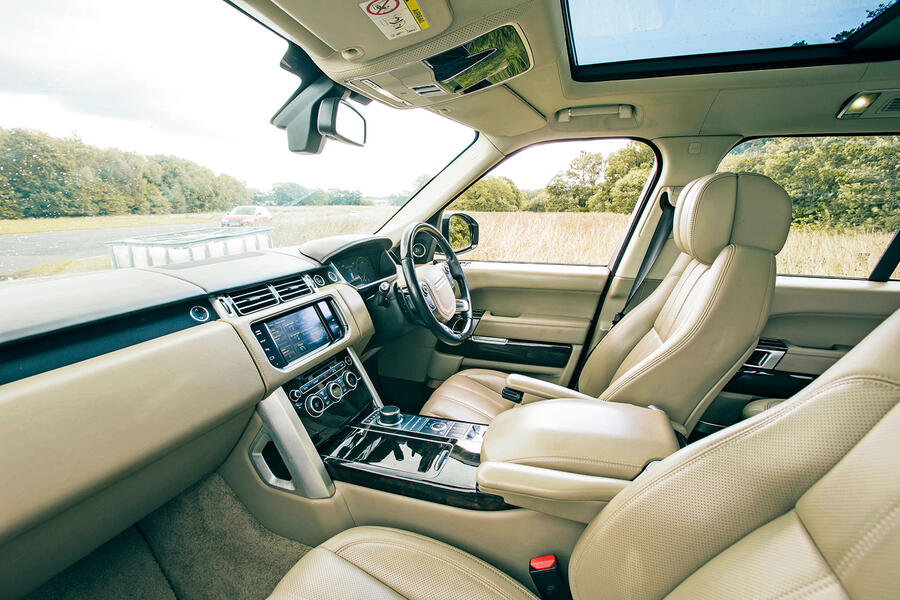
There are also regular hybrid and old-school diesel options for the Kia, but it can’t match the engine line-up of the Range Rover, which can be had with V6 and V8 diesel power, as well as a supercharged V8 like the one in our car.
It’s not an efficient option, but we would be lying if we said we weren’t seduced by its effortless turn of speed and distinguished soundtrack.
Regardless of engine choice, the Range Rover is hard to beat for comfort and unruffled progress, its long-travel air springs allowing it to float where the Kia fidgets.
The flipside is that the more tautly suspended Sorento handles with greater precision and less roll, although the Rangie hardly disgraces itself. And if you do want to head off the beaten track, this British institution remains the best 4x4 by some distance.
So far, so closely matched. However, you will have probably notice we haven’t touched on reliability or running costs yet. The truth is, old Land Rover products don’t have the best reputation for dependability, with the daily occurrence of dashboard warning lights a way of life for many.
Yet at this price point you will be able to bag a late and lightly used car, plus if you purchase through Land Rover’s approved used scheme there’s the lure of finance deals and a year’s warranty.
It’s not the seven years of cover that Kia offers, but it will help take some of the risk out of a pre-owned Rangie.
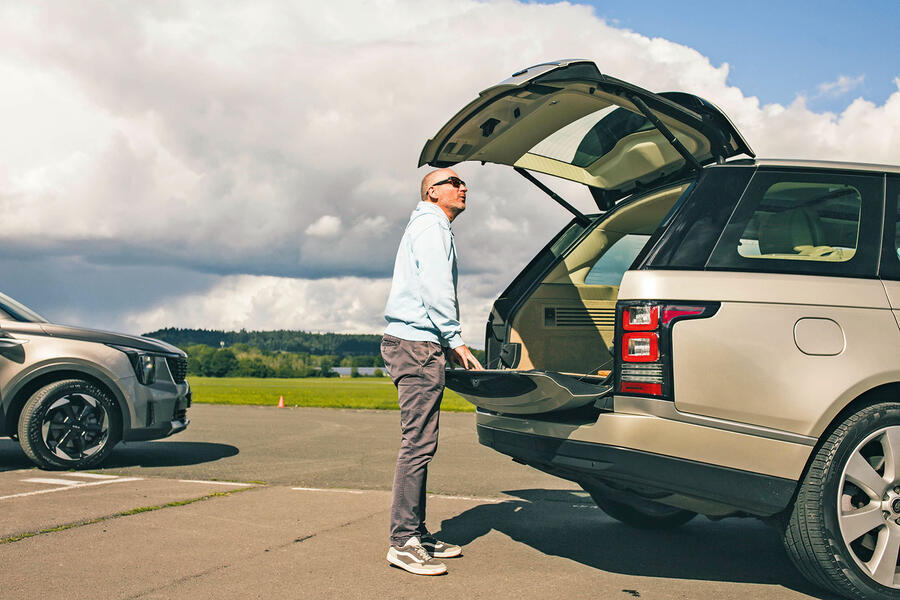
As with all of our contenders, the new versus used choice is really a head versus heart decision. The Kia is far from embarrassed in this encounter, offering 90% of the Range Rover’s abilities with lower running costs and greater long-term peace of mind.
However, we would take a deep breath, cross our fingers and enjoy the unique sense of style, luxury and well-being only the Rangie can offer.
